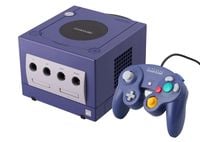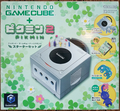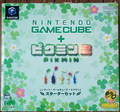Nintendo GameCube: Difference between revisions
(Removed controls.) |
CortexCPU242 (talk | contribs) (Added content) Tag: Mobile edit |
||
| (26 intermediate revisions by 12 users not shown) | |||
| Line 1: | Line 1: | ||
{{game icons|p=y|p2=y}} | {{game icons|p=y|p2=y}} | ||
[[File: | [[File:Nintendo GameCube.jpg|thumb|A Nintendo GameCube.]] | ||
The '''Nintendo GameCube''' is the home console for which | {{external|Nintendo GameCube|[[nintendo:Nintendo GameCube|NintendoWiki]]|NintendoWiki logo.png}} | ||
The '''Nintendo GameCube''' ({{j|ニンテンドーゲームキューブ|Nintendō Gēmukyūbu}}) is the home console for which {{p1}} and {{p2}} have been released. The two games have been released in 2001 and 2004 respectively. The console was released on {{date|14|September|2001}} in Japan, {{date|18|November|2001}} in North America, {{date|3|May|2002}} in Europe, and {{date|17|May|2002}} in Australia, and has sold over 21.74 million units worldwide{{cite web|https://www.nintendo.co.jp/ir/library/historical_data/pdf/consolidated_sales_e1603.pdf|Official Nintendo sales data|Nintendo.com}}. The console's successor, the [[Wii]], can also play GameCube games, and is the console for the re-releases of the ''Pikmin'' games in the ''[[New Play Control!]]'' range. The GameCube's controller consists of 6 buttons, 2 analog triggers, 2 analog sticks and the D-Pad. [[smashwiki:Super Smash Bros. Melee|''Super Smash Bros. Melee'']], a game in the [[Super Smash Bros. series|''Super Smash Bros.'' series]] was also released for the GameCube, and makes references to ''Pikmin''. In 2004, a tie-in bundle console was released in Japan for ''Pikmin 2''. | |||
==History== | ==History== | ||
Before being released in Japan, the GameCube's codename was "Dolphin". Due to this, some of the console's games have a reference to the codename, via an illustration or just a name. In ''Pikmin'''s case, it is the name of | Before being released in Japan, the GameCube's codename was "Dolphin". Due to this, some of the console's games have a reference to the codename, via an illustration or just a name. In ''Pikmin''{{'s}} case, it is the name of [[Captain Olimar]]'s spaceship, the [[S.S. Dolphin]]. | ||
==Memory Card== | ==Memory Card== | ||
There are three official GameCube memory card varieties: | There are three official GameCube memory card varieties: | ||
*59 blocks ( | *59 blocks (gray) | ||
*251 blocks (black) | *251 blocks (black) | ||
*1019 blocks (white) | *1019 blocks (white) | ||
In the ''Pikmin'' series, the first game requires 19 blocks, and the sequel 27. | In the ''Pikmin'' series, the first game requires 19 blocks, and the sequel 27. | ||
==In-game references== | |||
{{p4}} features two [[treasure]]s in the [[Newly Nostalgic Series]] that are related to the GameCube. These are the [[Winged Freedom Sculpture]], a GameCube controller, and the [[Glinty Circular Disc]], a Japanese disc of ''{{w|Wave Race: Blue Storm}}''. | |||
==Gallery== | |||
<gallery> | |||
A gamecube with Pikmin.jpg|Artwork of some [[Pikmin family|Pikmin]] with [[Captain Olimar]] on a Nintendo GameCube. | |||
GameCube Controller Clay Art.jpg|Clay art of a GameCube controller. | |||
Pikmin 2 GameCube Bundle Front.png|Bundle console box front. | |||
Pikmin 2 GameCube Bundle Back.png|Bundle console box back. | |||
Pikmin 2 GameCube Bundle Contents.png|Bundle console's contents, including the console, controller, and Purple Pikmin plush. | |||
</gallery> | |||
==External links== | ==External links== | ||
* | *{{w|GameCube|Wikipedia's article on the GameCube}} | ||
==References== | ==References== | ||
{{refs}} | |||
{{consoles}} | |||
[[Category:Consoles]] | [[Category:Consoles]] | ||
Latest revision as of 10:03, December 13, 2023
|
This article or section is a short summary on Nintendo GameCube. |
The Nintendo GameCube (ニンテンドーゲームキューブ?) is the home console for which Pikmin and Pikmin 2 have been released. The two games have been released in 2001 and 2004 respectively. The console was released on September 14th, 2001 in Japan, November 18th, 2001 in North America, May 3rd, 2002 in Europe, and May 17th, 2002 in Australia, and has sold over 21.74 million units worldwide[1]. The console's successor, the Wii, can also play GameCube games, and is the console for the re-releases of the Pikmin games in the New Play Control! range. The GameCube's controller consists of 6 buttons, 2 analog triggers, 2 analog sticks and the D-Pad. Super Smash Bros. Melee, a game in the Super Smash Bros. series was also released for the GameCube, and makes references to Pikmin. In 2004, a tie-in bundle console was released in Japan for Pikmin 2.
History[edit]
Before being released in Japan, the GameCube's codename was "Dolphin". Due to this, some of the console's games have a reference to the codename, via an illustration or just a name. In Pikmin's case, it is the name of Captain Olimar's spaceship, the S.S. Dolphin.
Memory Card[edit]
There are three official GameCube memory card varieties:
- 59 blocks (gray)
- 251 blocks (black)
- 1019 blocks (white)
In the Pikmin series, the first game requires 19 blocks, and the sequel 27.
In-game references[edit]
Pikmin 4 features two treasures in the Newly Nostalgic Series that are related to the GameCube. These are the Winged Freedom Sculpture, a GameCube controller, and the Glinty Circular Disc, a Japanese disc of Wave Race: Blue Storm.
Gallery[edit]
Artwork of some Pikmin with Captain Olimar on a Nintendo GameCube.
External links[edit]
References[edit]
- ^ Official Nintendo sales data on Nintendo.com
| Nintendo consoles | |
|---|---|
| GameCube • Wii • Wii U • 3DS • Switch | |





